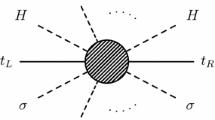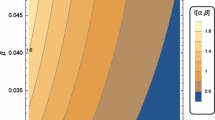Abstract
We construct the non-linear realized Lagrangian for the Goldstone bosons associated to the breaking pattern of SU(4) to SO(4). This pattern is expected to occur in any Technicolor extension of the standard model featuring two Dirac fermions transforming according to real representations of the underlying gauge group. We concentrate on the Minimal Walking Technicolor quantum number assignments with respect to the standard model symmetries. We demonstrate that for, any choice of the quantum numbers, consistent with gauge and Witten anomalies the spectrum of the pseudo Goldstone Bosons contains electrically doubly charged states which can be discovered at the Large Hadron Collider.





Similar content being viewed by others
Notes
However, in a few cases certain patterns have been confirmed. For example for the SU(2) TC theory with two Dirac fermions transforming according to the fundamental representation of the underlying TC gauge group there is a definitive Lattice proof [13] that SU(4) breaks to Sp(4). The effective, linear and non-linear, Lagrangians for SU(4) breaking to Sp(4) describing also the interactions with the SM have been constructed in [14–16].
We use the two component Weyl notation throughout the paper.
A detailed discussion regarding the vacuum alignment for MWT can be found in [31].
Bound states made by one technifermion and one technigluon have electric charge \(-\frac{y \pm1}{2}\).
Conventions regarding SM quantum numbers are reported in Appendix B.
References
S. Weinberg, Phys. Rev. D 19, 1277 (1979)
L. Susskind, Phys. Rev. D 20, 2619 (1979)
J.R. Andersen et al., Eur. Phys. J. Plus 126, 81 (2011). arXiv:1104.1255 [hep-ph]
J.R. Andersen, T. Hapola, F. Sannino, arXiv:1105.1433 [hep-ph]
A. Belyaev, R. Foadi, M.T. Frandsen, M. Jarvinen, F. Sannino, A. Pukhov, Phys. Rev. D 79, 035006 (2009). arXiv:0809.0793 [hep-ph]
H.J. He et al., Phys. Rev. D 78, 031701 (2008). arXiv:0708.2588 [hep-ph]
E. Accomando, S. De Curtis, D. Dominici, L. Fedeli, Phys. Rev. D 79, 055020 (2009). arXiv:0807.5051 [hep-ph]
R. Barbieri, G. Isidori, V.S. Rychkov, E. Trincherini, Phys. Rev. D 78, 036012 (2008). arXiv:0806.1624 [hep-ph]
J. Hirn, A. Martin, V. Sanz, J. High Energy Phys. 0805, 084 (2008). arXiv:0712.3783 [hep-ph]
O. Cata, G. Isidori, J.F. Kamenik, Nucl. Phys. B 822, 230 (2009). arXiv:0905.0490 [hep-ph]
M.E. Peskin, Nucl. Phys. B 175, 197 (1980)
J. Preskill, Nucl. Phys. B 177, 21 (1981)
R. Lewis, C. Pica, F. Sannino, Phys. Rev. D 85, 014504 (2012). arXiv:1109.3513 [hep-ph]
Z.y. Duan, P.S. Rodrigues da Silva, F. Sannino, Nucl. Phys. B 592, 371 (2001). arXiv:hep-ph/0001303
T. Appelquist, P.S. Rodrigues da Silva, F. Sannino, Phys. Rev. D 60, 116007 (1999). arXiv:hep-ph/9906555
T.A. Ryttov, F. Sannino, Phys. Rev. D 78, 115010 (2008). arXiv:0809.0713 [hep-ph]
F. Sannino, K. Tuominen, Phys. Rev. D 71, 051901 (2005). arXiv:hep-ph/0405209
D.K. Hong, S.D.H. Hsu, F. Sannino, Phys. Lett. B 597, 89 (2004). arXiv:hep-ph/0406200
D.D. Dietrich, F. Sannino, K. Tuominen, Phys. Rev. D 72, 055001 (2005). arXiv:hep-ph/0505059
N. Evans, F. Sannino, arXiv:hep-ph/0512080
R. Foadi, M.T. Frandsen, T.A. Ryttov, F. Sannino, Phys. Rev. D 76, 055005 (2007). arXiv:0706.1696 [hep-ph]
M.T. Frandsen, F. Sannino, Phys. Rev. D 81, 097704 (2010). arXiv:0911.1570 [hep-ph]
F. Sannino, Phys. Rev. D 79, 096007 (2009). arXiv:0902.3494 [hep-ph]
D.D. Dietrich, F. Sannino, Phys. Rev. D 75, 085018 (2007). arXiv:hep-ph/0611341
T.A. Ryttov, F. Sannino, Phys. Rev. D 78, 065001 (2008). arXiv:0711.3745 [hep-th]
C. Pica, F. Sannino, Phys. Rev. D 83, 116001 (2011). arXiv:1011.3832 [hep-ph]
C. Pica, F. Sannino, Phys. Rev. D 83, 035013 (2011). arXiv:1011.5917 [hep-ph]
H.S. Fukano, F. Sannino, Phys. Rev. D 82, 035021 (2010). arXiv:1005.3340 [hep-ph]
R.S. Chivukula, P. Ittisamai, E.H. Simmons, J. Ren, Phys. Rev. D 84, 115025 (2011). arXiv:1110.3688 [hep-ph]
E. Witten, Phys. Lett. B 117, 324 (1982)
D.D. Dietrich, M. Jarvinen, Phys. Rev. D 79, 057903 (2009). arXiv:0901.3528 [hep-ph]
E. Eichten, K.D. Lane, Phys. Lett. B 90, 125 (1980)
S. Dimopoulos, L. Susskind, Nucl. Phys. B 155, 237 (1979)
M. Fairbairn, A.C. Kraan, D.A. Milstead, T. Sjostrand, P.Z. Skands, T. Sloan, Phys. Rep. 438, 1 (2007). arXiv:hep-ph/0611040
https://twiki.cern.ch/twiki/bin/view/AtlasPublic/ExoticsPublicResults
https://twiki.cern.ch/twiki/bin/view/CMSPublic/PhysicsResultsEXO
E. Farhi, L. Susskind, Phys. Rep. 74, 277 (1981)
R. Casalbuoni, A. Deandrea, S. De Curtis, D. Dominici, R. Gatto, J.F. Gunion, Nucl. Phys. B 555, 3 (1999). arXiv:hep-ph/9809523
K.D. Lane, M.V. Ramana, Phys. Rev. D 44, 2678 (1991)
K.D. Lane, Phys. Rev. D 60, 075007 (1999). arXiv:hep-ph/9903369
A. Manohar, L. Randall, Phys. Lett. B 246, 537 (1990)
J. Alwall, M. Herquet, F. Maltoni, O. Mattelaer, T. Stelzer, J. High Energy Phys. 1106, 128 (2011). arXiv:1106.0522 [hep-ph]
N.D. Christensen, C. Duhr, Comput. Phys. Commun. 180, 1614 (2009). arXiv:0806.4194 [hep-ph]
J. Pumplin, D.R. Stump, J. Huston, H.L. Lai, P.M. Nadolsky, W.K. Tung, J. High Energy Phys. 0207, 012 (2002). arXiv:hep-ph/0201195
E. Del Nobile, R. Franceschini, D. Pappadopulo, A. Strumia, Nucl. Phys. B 826, 217 (2010). arXiv:0908.1567 [hep-ph]
A.G. Akeroyd, S. Moretti, H. Sugiyama, arXiv:1201.5047 [hep-ph]
O. Antipin, M. Heikinheimo, K. Tuominen, J. High Energy Phys. 0910, 018 (2009). arXiv:0905.0622 [hep-ph]
CMS-PAS-HIG-11-007, http://cdsweb.cern.ch/record/1369542
ATLAS-CONF-2011-127, http://cdsweb.cern.ch/record/1383792
A. Read, Technical Report CERN-OPEN-2000-005, CERN (2000)
T. Junk, Nucl. Instrum. Methods Phys. Res., Sect. A, Accel. Spectrom. Detect. Assoc. Equip. 434, 435 (1999). hep-ex/9902006
G. Azuelos, K. Benslama, J. Ferland, J. Phys. G 32, 73 (2006). arXiv:hep-ph/0503096
M. Perelstein, Prog. Part. Nucl. Phys. 58, 247 (2007). arXiv:hep-ph/0512128
J.E. Cieza Montalvo, N.V. Cortez, J. Sa Borges, M.D. Tonasse, Nucl. Phys. B 756, 1 (2006) [Erratum-ibid. B 796, 422 (2008)]. hep-ph/0606243
Acknowledgements
We are happy to thank the CP3-Origins colleagues for fruitful discussions. We also kindly acknowledge discussions with Claude Duhr, Roshan Foadi, Mads T. Frandsen and Luca Vecchi. F.M. acknowledges the financial support from projects FPA2010-20807, 2009SGR502 and Consolider CPAN, and CSD2007-00042.
Author information
Authors and Affiliations
Corresponding author
Appendices
Appendix A: SU(4) generators and PGBs quantum numbers
It is convenient to use the following representation of the SU(4) hermitian generators:

where A is hermitian, C is hermitian and traceless, B=−B T and D=D T. The S are also a representation of the SO(4) generators, and thus leave the vacuum invariant SE+ES T=0 . Explicitly, the generators read

where a=1,2,3 are the Pauli matrices and  . These are the generators of SU(2)
V
×U(1)
V
.
. These are the generators of SU(2)
V
×U(1)
V
.

with

Notice that S 4,S 5 and S 6 are the generators of another SU(2) V′ algebra and that SO(4)≃SU(2) V ×SU(2) V′.
The remaining generators which do not leave the vacuum invariant are

and

with

The generators are normalized as follows:

The electroweak subgroup can be embedded in SU(4), as explained in detail in [15].
The S a generators, with a=1,…,4, together with the X a generators, with a=1,2,3, generate an SU(2) L ×SU(2) R ×U(1) V algebra. This is easily seen by changing the generator basis from (S a,X a) to (L a,R a), where

with a=1,2,3. The electroweak gauge group is then obtained by gauging SU(2) L , and the U(1) Y subgroup of SU(2) R ×U(1) V , where

The gauging of the electroweak group breaks explicitly SU(4) down to \(\mathcal{H}'=\mathit{SU}(2)_{L} \times U(1)_{V} \times U(1)_{Y}\). As SU(4) spontaneously breaks to \(\mathcal{H}= \mathit{SO}(4)\), SU(2) L ×SU(2) R breaks to SU(2) V , which acts as a custodial isospin, which insures that the ρ parameter is equal to one at tree level.
As a consequence of the explicit and spontaneous breaking of SU(4), the unbroken subgroup is given by \(\mathcal{H} \cap\mathcal{H}'=U(1)_{V} \times U(1)_{Q} \). The electromagnetic group is generated by

We also normalize the U(1) V generators in the following way:

In order to couple the PGB to the SM fermions we study the transformation properties of the matrix U. Under SU(4), the matrix U transforms as a two index symmetric tensor, or in other words U transforms like the irreducible representation 10 of SU(4).
Knowing the embedding of the electroweak generators in the SU(4) algebra it is possible to decompose the representation 10 according to the electroweak gauge group. It is useful to consider the following decomposition chain:

according to which


It is convenient to introduce the following notation:

as well as

with the following form for the projectors P:

Appendix B: Standard Model quantum numbers

with i=1,2,3.
Appendix C: An effective Lagrangian for gluon fusion
An effective interaction term for the PGB production via gluon fusion reads
With our convention for the couplings y 1 and y 2, all the PGBs couple to the top proportionally to its mass, similarly to the SM Higgs. Therefore the function g(τ) can be read off directly from the Higgs-gluon-gluon effective coupling upon substituting the top Yukawa coupling with (27), and replacing \(m_{H}^{2}\) in the loop factor with (p+q)2, where p and q are the momenta of the final state PGBs. We have \(\tau=\frac{4 m_{t}^{2}}{(p+q)^{2}}\) and
where
Of course α s and G F are, respectively, the strong and the Fermi coupling constant.
Rights and permissions
About this article
Cite this article
Hapola, T., Mescia, F., Nardecchia, M. et al. Pseudo Goldstone Bosons phenomenology in Minimal Walking Technicolor. Eur. Phys. J. C 72, 2063 (2012). https://doi.org/10.1140/epjc/s10052-012-2063-5
Received:
Revised:
Published:
DOI: https://doi.org/10.1140/epjc/s10052-012-2063-5




